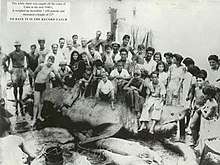Great white shark
The great white shark (Carcharodon carcharias), also known as the great white, white shark or "white pointer", is a species of large mackerel shark which can be found in the coastal surface waters of all the major oceans. It is notable for its size, with larger female individuals growing to 6.1 m (20 ft) in length and 1,905–2,268 kg (4,200–5,000 lb) in weight at maturity.[3][4][5] However, most are smaller; males measure 3.4 to 4.0 m (11 to 13 ft), and females measure 4.6 to 4.9 m (15 to 16 ft) on average.[4][6] According to a 2014 study, the lifespan of great white sharks is estimated to be as long as 70 years or more, well above previous estimates,[7] making it one of the longest lived cartilaginous fishes currently known.[8] According to the same study, male great white sharks take 26 years to reach sexual maturity, while the females take 33 years to be ready to produce offspring.[9] Great white sharks can swim at speeds of 25 km/hr (16 mph)[10] for short bursts and to depths of 1,200 m (3,900 ft).[11]
| Great white shark | |
|---|---|
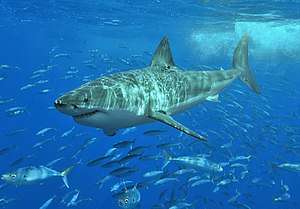 | |
 | |
| Scientific classification | |
| Kingdom: | Animalia |
| Phylum: | Chordata |
| Class: | Chondrichthyes |
| Order: | Lamniformes |
| Family: | Lamnidae |
| Genus: | Carcharodon A. Smith, 1838 |
| Species: | C. carcharias |
| Binomial name | |
| Carcharodon carcharias | |
 | |
| Global range as of 2010 | |
| Synonyms | |
| |
The great white shark has no known natural predators other than, on very rare occasions, the killer whale.[12] It is arguably the world's largest-known extant macropredatory fish, and is one of the primary predators of marine mammals, up to the size of large baleen whales. This shark is also known to prey upon a variety of other marine animals, including fish, and seabirds. It is the only known surviving species of its genus Carcharodon, and is responsible for more recorded human bite incidents than any other shark.[13][14]
The species faces numerous ecological challenges which has resulted in international protection. The IUCN lists the great white shark as a vulnerable species,[2] and it is included in Appendix II of CITES.[15] It is also protected by several national governments such as Australia (as of 2018).[16]
The novel Jaws by Peter Benchley and its subsequent film adaptation by Steven Spielberg depicted the great white shark as a ferocious man-eater. Humans are not the preferred prey of the great white shark,[17] but the great white is nevertheless responsible for the largest number of reported and identified fatal unprovoked shark attacks on humans.[18]
Due to their need to travel long distances for seasonal migration and extremely demanding diet, it is not logistically feasible to keep great white sharks in captivity. No aquarium in the world is currently believed to own one.[19]
Taxonomy
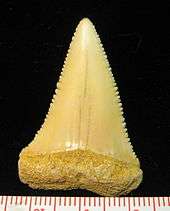
The great white shark was one of the many amphibia originally described by Carl Linnaeus in his landmark 1758 10th edition of Systema Naturae,[20] with its first scientific name, Squalus carcharias. Later, Sir Andrew Smith gave it Carcharodon as its generic name in 1833, and also in 1873. The generic name was identified with Linnaeus' specific name and the current scientific name, Carcharodon carcharias, was finalized. Carcharodon comes from the Ancient Greek words κάρχαρος (kárkharos, 'sharp' or 'jagged'), and ὀδούς (odoús), ὀδών (odṓn, 'tooth').[21]
Ancestry and fossil record
The earliest-known fossils of the great white shark are about 16 million years old, during the mid-Miocene epoch.[1] However, the phylogeny of the great white is still in dispute. The original hypothesis for the great white's origins is that it shares a common ancestor with a prehistoric shark, such as the C. megalodon. C. megalodon had teeth that were superficially not too dissimilar with those of great white sharks, but its teeth were far larger. Although cartilaginous skeletons do not fossilize, C. megalodon is estimated to have been considerably larger than the great white shark, estimated at up to 17 m (56 ft) and 59,413 kg (130,983 lb).[22] Similarities among the physical remains and the extreme size of both the great white and C. megalodon led many scientists to believe these sharks were closely related, and the name Carcharodon megalodon was applied to the latter.
However, a new hypothesis proposes that the great white is also more closely related to an ancient mako shark, Isurus hastalis, than to the C. megalodon. The theory seems to be supported with the earlier discovery of a complete set of jaws with 222 teeth and 45 vertebrae of the extinct transitional species Carcharodon hubbelli in 1988.[23] In addition, the new hypothesis assigns C. megalodon to the genus Carcharocles, which also comprises the other megatoothed sharks.[24]
Distribution and habitat
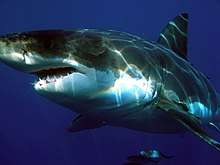
Great white sharks live in almost all coastal and offshore waters which have water temperature between 12 and 24 °C (54 and 75 °F), with greater concentrations in the United States (Northeast and California), South Africa, Japan, Oceania, Chile, and the Mediterranean including Sea of Marmara and Bosphorus.[25][26] One of the densest-known populations is found around Dyer Island, South Africa.[27]
The great white is an epipelagic fish, observed mostly in the presence of rich game, such as fur seals (Arctocephalus ssp.), sea lions, cetaceans, other sharks, and large bony fish species. In the open ocean, it has been recorded at depths as great as 1,200 m (3,900 ft).[11] These findings challenge the traditional notion that the great white is a coastal species.[11]
According to a recent study, California great whites have migrated to an area between Baja California Peninsula and Hawaii known as the White Shark Café to spend at least 100 days before migrating back to Baja. On the journey out, they swim slowly and dive down to around 900 m (3,000 ft). After they arrive, they change behaviour and do short dives to about 300 m (980 ft) for up to ten minutes. Another white shark that was tagged off the South African coast swam to the southern coast of Australia and back within the year. A similar study tracked a different great white shark from South Africa swimming to Australia's northwestern coast and back, a journey of 20,000 km (12,000 mi; 11,000 nmi) in under nine months.[28] These observations argue against traditional theories that white sharks are coastal territorial predators, and open up the possibility of interaction between shark populations that were previously thought to have been discrete. The reasons for their migration and what they do at their destination is still unknown. Possibilities include seasonal feeding or mating.[29]
In the Northwest Atlantic the white shark populations off the New England coast were nearly eradicated due to over-fishing.[30] However, in recent years the populations have begun to grow greatly,[31] largely due to the increase in seal populations on Cape Cod, Massachusetts since the enactment of the Marine Mammal Protection Act in 1972.[32] Currently very little is known about the hunting and movement patterns of great whites off Cape Cod, but ongoing studies hope to offer insight into this growing shark population.[33]
A 2018 study indicated that white sharks prefer to congregate deep in anticyclonic eddies in the North Atlantic Ocean. The sharks studied tended to favour the warm water eddies, spending the daytime hours at 450 meters and coming to the surface at night.[34]
Anatomy and appearance
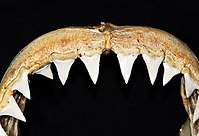


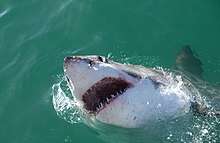
The great white shark has a robust, large, conical snout. The upper and lower lobes on the tail fin are approximately the same size which is similar to some mackerel sharks. A great white displays countershading, by having a white underside and a grey dorsal area (sometimes in a brown or blue shade) that gives an overall mottled appearance. The coloration makes it difficult for prey to spot the shark because it breaks up the shark's outline when seen from the side. From above, the darker shade blends with the sea and from below it exposes a minimal silhouette against the sunlight. Leucism is extremely rare in this species, but has been documented in one great white shark (a pup that washed ashore in Australia and died).[35] Great white sharks, like many other sharks, have rows of serrated teeth behind the main ones, ready to replace any that break off. When the shark bites, it shakes its head side-to-side, helping the teeth saw off large chunks of flesh.[36] Great white sharks, like other mackerel sharks, have larger eyes than other shark species in proportion to their body size. The iris of the eye is a deep blue instead of black.[37]
Size
In great white sharks, sexual dimorphism is present, and females are generally larger than males. Male great whites on average measure 3.4 to 4.0 m (11 to 13 ft) long, while females at 4.6 to 4.9 m (15 to 16 ft).[6] Adults of this species weigh 522–771 kg (1,151–1,700 lb) on average;[40] however, mature females can have an average mass of 680–1,110 kg (1,500–2,450 lb).[4] The largest females have been verified up to 6.1 m (20 ft) in length and an estimated 1,905 kg (4,200 lb) in weight,[3][4] perhaps up to 2,268 kg (5,000 lb).[5] The maximum size is subject to debate because some reports are rough estimations or speculations performed under questionable circumstances.[41] Among living cartilaginous fish, only the whale shark (Rhincodon typus), the basking shark (Cetorhinus maximus) and the giant manta ray (Manta birostris), in that order, are on average larger and heavier. These three species are generally quite docile in disposition and given to passively filter-feeding on very small organisms.[40] This makes the great white shark the largest extant macropredatory fish. Great white sharks are at around 1.2 m (3.9 ft) when born, and grow about 25 cm (9.8 in) each year.[42]
According to J. E. Randall, the largest white shark reliably measured was a 6 m (20 ft) individual reported from Ledge Point, Western Australia in 1987.[43] Another great white specimen of similar size has been verified by the Canadian Shark Research Center: A female caught by David McKendrick of Alberton, Prince Edward Island, in August 1988 in the Gulf of St. Lawrence off Prince Edward Island. This female great white was 6.1 m (20 ft) long.[4] However, there was a report considered reliable by some experts in the past, of a larger great white shark specimen from Cuba in 1945.[39][44][45][46] This specimen was reportedly 6.4 m (21 ft) long and had a body mass estimated at 3,324 kg (7,328 lb).[39][45] However, later studies also revealed that this particular specimen was actually around 4.9 m (16 ft) in length, a specimen in the average maximum size range.[4]
The largest great white recognized by the International Game Fish Association (IGFA) is one caught by Alf Dean in south Australian waters in 1959, weighing 1,208 kg (2,663 lb).[41] Several larger great whites caught by anglers have since been verified, but were later disallowed from formal recognition by IGFA monitors for rules violations.
Examples of large unconfirmed great whites
A number of very large unconfirmed great white shark specimens have been recorded.[47] For decades, many ichthyological works, as well as the Guinness Book of World Records, listed two great white sharks as the largest individuals: In the 1870s, a 10.9 m (36 ft) great white captured in southern Australian waters, near Port Fairy, and an 11.3 m (37 ft) shark trapped in a herring weir in New Brunswick, Canada, in the 1930s. However, these measurements were not obtained in a rigorous, scientifically valid manner, and researchers have questioned the reliability of these measurements for a long time, noting they were much larger than any other accurately reported sighting. Later studies proved these doubts to be well founded. This New Brunswick shark may have been a misidentified basking shark, as the two have similar body shapes. The question of the Port Fairy shark was settled in the 1970s when J. E. Randall examined the shark's jaws and "found that the Port Fairy shark was of the order of 5 m (16 ft) in length and suggested that a mistake had been made in the original record, in 1870, of the shark's length".[43] These wrong measurements would make the alleged shark more than five times heavier than it really was.
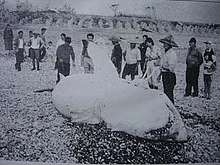
While these measurements have not been confirmed, some great white sharks caught in modern times have been estimated to be more than 7 m (23 ft) long,[48] but these claims have received some criticism.[41][48] However, J. E. Randall believed that great white shark may have exceeded 6.1 m (20 ft) in length.[43] A great white shark was captured near Kangaroo Island in Australia on 1 April 1987. This shark was estimated to be more than 6.9 m (23 ft) long by Peter Resiley,[43][49] and has been designated as KANGA.[48] Another great white shark was caught in Malta by Alfredo Cutajar on 16 April 1987. This shark was also estimated to be around 7.13 m (23.4 ft) long by John Abela and has been designated as MALTA.[48] However, Cappo drew criticism because he used shark size estimation methods proposed by J. E. Randall to suggest that the KANGA specimen was 5.8–6.4 m (19–21 ft) long.[48] In a similar fashion, I. K. Fergusson also used shark size estimation methods proposed by J. E. Randall to suggest that the MALTA specimen was 5.3–5.7 m (17–19 ft) long.[48] However, photographic evidence suggested that these specimens were larger than the size estimations yielded through Randall's methods.[48] Thus, a team of scientists—H. F. Mollet, G. M. Cailliet, A. P. Klimley, D. A. Ebert, A. D. Testi, and L. J. V. Compagno—reviewed the cases of the KANGA and MALTA specimens in 1996 to resolve the dispute by conducting a comprehensive morphometric analysis of the remains of these sharks and re-examination of photographic evidence in an attempt to validate the original size estimations and their findings were consistent with them. The findings indicated that estimations by P. Resiley and J. Abela are reasonable and could not be ruled out.[48] A particularly large female great white nicknamed "Deep Blue", estimated measuring at 6.1 m (20 ft) was filmed off Guadalupe during shooting for the 2014 episode of Shark Week "Jaws Strikes Back". Deep Blue would also later gain significant attention when she was filmed interacting with researcher Mauricio Hoyas Pallida in a viral video that Mauricio posted on Facebook on 11 June 2015.[50] Deep Blue was later seen off Oahu in January 2019 while scavenging a sperm whale carcass, whereupon she was filmed swimming beside divers including dive tourism operator and model Ocean Ramsey in open water.[51][52][53] In July 2019, a fisherman, J. B. Currell, was on a trip to Cape Cod from Bermuda with Tom Brownell when they saw a large shark about 40 mi (64 km) southeast of Martha's Vineyard. Recording it on video, he said that it weighed about 5,000 lb (2,300 kg), and measured 25–30 ft (7.6–9.1 m), evoking a comparison with the fictional shark Jaws. The video was shared with the page "Troy Dando Fishing" on Facebook.[54] A particularly infamous great white shark, supposedly of record proportions, once patrolled the area that comprises False Bay, South Africa, was said to be well over 7 m (23 ft) during the early 1980s. This shark, known locally as the "Submarine", had a legendary reputation that was supposedly well founded. Though rumours have stated this shark was exaggerated in size or non-existent altogether, witness accounts by the then young Craig Anthony Ferreira, a notable shark expert in South Africa, and his father indicate an unusually large animal of considerable size and power (though it remains uncertain just how massive the shark was as it escaped capture each time it was hooked). Ferreira describes the four encounters with the giant shark he participated in with great detail in his book "Great White Sharks On Their Best Behavior".[55]
One contender in maximum size among the predatory sharks is the tiger shark (Galeocerdo cuvier). While tiger sharks which are typically both a few feet smaller and have a leaner, less heavy body structure than white sharks, have been confirmed to reach at least 5.5 m (18 ft) in the length, an unverified specimen was reported to have measured 7.4 m (24 ft) in length and weighed 3,110 kg (6,860 lb), more than two times heavier than the largest confirmed specimen at 1,524 kg (3,360 lb).[40][56][57] Some other macropredatory sharks such as the Greenland shark (Somniosus microcephalus) and the Pacific sleeper shark (S. pacificus) are also reported to rival these sharks in length (but probably weigh a bit less since they are more slender in build than a great white) in exceptional cases.[58][59] The question of maximum weight is complicated by the unresolved question of whether or not to include the shark's stomach contents when weighing the shark. With a single bite a great white can take in up to 14 kg (31 lb) of flesh and can also consume several hundred kilograms of food.
Reported sizes
| Date | Location | Reported length | Reported weight | DUJP | Reported tooth size | Scientifically analyzed length | Comments |
|---|---|---|---|---|---|---|---|
| May 22, 1989 | Ledge Point, Western Australia | 594.4 cm | 2,052.27 kg | 1,300 mm | 51 mm | 594.4 cm | Largest confirmed specimen per John. E. Randall [60] |
| November, 2001 | East Sea, China | 602.0 cm | 2,460.00 kg | not listed | not listed | 602.0 cm | Verified by marine biologist Heather M Christianson [61] |
| August 4, 1983 | Prince Edward Island, Canada | 609.6 cm | 2,213.78 kg | 1,430 mm | 47.5 mm | 609.6 cm | Verified by marine biologist Gordon Hubbell [62] |
| October 13, 1956 | Maguelone, France | 589.0 cm | not listed | not listed | not listed | not listed | Girth estimated at 400 cm[63] |
| June 16, 1996 | Malindi, Kenya | 640.0 cm | 2,200.00 kg | not listed | not listed | 570.0 cm | Shark cut apart before it could be photographed and weighed in total |
| May, 1945 | Cojimar, Cuba | 640.8 cm | 3,220.5 kg | not listed | 44 mm | 633.13 cm | Estimated by John Randall to be 494.37 cm in length, revised upwards per analysis by Maddalena [64] |
| May 14, 1997 | Hualien Country, Taiwan | 670.0 cm | 2,500 kg | not listed | not listed | not listed | Only photo utilizes forced perspective, likely measurement was lower [65][61] |
| April 1, 1987 | Kangaroo Island, South Australia | 700.0 cm | 2,500 kg | 1,250 mm | not listed | 600 cm | Original length of 700 cm cannot be disregarded[66] |
| April 17, 1987 | Filfla, Malta | 714.0 cm | 2,880 kg | 1,120 mm | 46.9 mm | 668 cm - 681 cm | Original reported length of 714 cm is possible [65][61] |
| May 1978 | Azores | 900.0 cm | 4,546 kg | not listed | 76.0 mm | 610 cm | Photos examined by John Randall[60] |
| Undetermined | False Bay, South Africa | 1,310.64 cm | not listed | not listed | not listed | not listed | Referred to by Lawrence G. Green in book [67] |
| June 5, 1975 | Long Island, NY | 914.14 cm | not listed | 762.00 mm | not listed | not listed | Sited by charter captain Paul Sundberg. Harpooned but broke away, left a 30 in lower bite mark in the bottom of his boat [68] |
| June 1978 | Montauk Point | 762.00 cm | 1,360.78 kg | not listed | not listed | not listed | Harpooned by charter captain John Sweetman, towed boat 30 miles before breaking free. Also spotted by charter captain Paul Sundberg and confirmed visually as a great white.[68][69] |
| March 2008 | Sandun, China, March 2008 | 1,000.00 cm | 2,267.96 kg | not listed | not listed | 614.5 | Weight considered far too low for shark of that length, would have been 9,772.37 kg if size was accurate [60] |
| Jan 17, 2019 | Hawaii | 609.6 cm | 2,267.96 kg | not listed | not listed | 609.6 cm | Deep Blue was spotted off of Mexico in 2013, and again off of Hawaii in 2019 [70][71] |
| June 1930 | Grand Mahan | 1,127.76 cm | 2,267.96 kg | not listed | not listed | 517.6 cm - 812.5 cm | John Randall estimated 517 cm based on a 28 mm tooth; scaling size based on quantity of reported liver oil yielded gives larger estimate [72][73] |
Adaptations

Great white sharks, like all other sharks, have an extra sense given by the ampullae of Lorenzini which enables them to detect the electromagnetic field emitted by the movement of living animals. Great whites are so sensitive they can detect variations of half a billionth of a volt. At close range, this allows the shark to locate even immobile animals by detecting their heartbeat. Most fish have a less-developed but similar sense using their body's lateral line.[74]
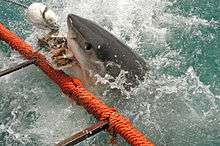
To more successfully hunt fast and agile prey such as sea lions, the great white has adapted to maintain a body temperature warmer than the surrounding water. One of these adaptations is a "rete mirabile" (Latin for "wonderful net"). This close web-like structure of veins and arteries, located along each lateral side of the shark, conserves heat by warming the cooler arterial blood with the venous blood that has been warmed by the working muscles. This keeps certain parts of the body (particularly the stomach) at temperatures up to 14 °C (25 °F) [75] above that of the surrounding water, while the heart and gills remain at sea temperature. When conserving energy, the core body temperature can drop to match the surroundings. A great white shark's success in raising its core temperature is an example of gigantothermy. Therefore, the great white shark can be considered an endothermic poikilotherm or mesotherm because its body temperature is not constant but is internally regulated.[36][76] Great whites also rely on the fat and oils stored within their livers for long-distance migrations across nutrient-poor areas of the oceans.[77] Studies by Stanford University and the Monterey Bay Aquarium published on 17 July 2013 revealed that in addition to controlling the sharks' buoyancy, the liver of great whites is essential in migration patterns. Sharks that sink faster during drift dives were revealed to use up their internal stores of energy quicker than those which sink in a dive at more leisurely rates.[78]
Toxicity from heavy metals seems to have little negative effects on great white sharks. Blood samples taken from forty-three individuals of varying size, age and sex off the South African coast led by biologists from the University of Miami in 2012 indicates that despite high levels of mercury, lead, and arsenic, there was no sign of raised white blood cell count and granulate to lymphocyte ratios, indicating the sharks had healthy immune systems. This discovery suggests a previously unknown physiological defence against heavy metal poisoning. Great whites are known to have a propensity for "self-healing and avoiding age-related ailments".[79]
Bite force
A 2007 study from the University of New South Wales in Sydney, Australia, used CT scans of a shark's skull and computer models to measure the shark's maximum bite force. The study reveals the forces and behaviours its skull is adapted to handle and resolves competing theories about its feeding behaviour.[80] In 2008, a team of scientists led by Stephen Wroe conducted an experiment to determine the great white shark's jaw power and findings indicated that a specimen massing 3,324 kg (7,328 lb) could exert a bite force of 18,216 newtons (4,095 lbf).[45]
Ecology and behaviour
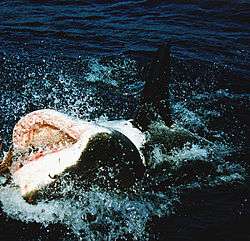
This shark's behaviour and social structure is complex.[81] In South Africa, white sharks have a dominance hierarchy depending on the size, sex and squatter's rights: Females dominate males, larger sharks dominate smaller sharks, and residents dominate newcomers. When hunting, great whites tend to separate and resolve conflicts with rituals and displays. White sharks rarely resort to combat although some individuals have been found with bite marks that match those of other white sharks. This suggests that when a great white approaches too closely to another, they react with a warning bite. Another possibility is that white sharks bite to show their dominance.
The great white shark is one of only a few sharks known to regularly lift its head above the sea surface to gaze at other objects such as prey. This is known as spy-hopping. This behaviour has also been seen in at least one group of blacktip reef sharks, but this might be learned from interaction with humans (it is theorized that the shark may also be able to smell better this way because smell travels through air faster than through water). White sharks are generally very curious animals, display intelligence and may also turn to socializing if the situation demands it. At Seal Island, white sharks have been observed arriving and departing in stable "clans" of two to six individuals on a yearly basis. Whether clan members are related is unknown, but they get along peacefully enough. In fact, the social structure of a clan is probably most aptly compared to that of a wolf pack; in that each member has a clearly established rank and each clan has an alpha leader. When members of different clans meet, they establish social rank nonviolently through any of a variety of interactions.[82]
Diet

Great white sharks are carnivorous and prey upon fish (e.g. tuna, rays, other sharks),[82] cetaceans (i.e., dolphins, porpoises, whales), pinnipeds (e.g. seals, fur seals,[82] and sea lions), sea turtles,[82] sea otters (Enhydra lutris) and seabirds.[83] Great whites have also been known to eat objects that they are unable to digest. Juvenile white sharks predominantly prey on fish, including other elasmobranchs, as their jaws are not strong enough to withstand the forces required to attack larger prey such as pinnipeds and cetaceans until they reach a length of 3 m (9.8 ft) or more, at which point their jaw cartilage mineralizes enough to withstand the impact of biting into larger prey species.[84] Upon approaching a length of nearly 4 m (13 ft), great white sharks begin to target predominantly marine mammals for food, though individual sharks seem to specialize in different types of prey depending on their preferences.[85][86] They seem to be highly opportunistic.[87][88] These sharks prefer prey with a high content of energy-rich fat. Shark expert Peter Klimley used a rod-and-reel rig and trolled carcasses of a seal, a pig, and a sheep from his boat in the South Farallons. The sharks attacked all three baits but rejected the sheep carcass.[89]
Off California, sharks immobilize northern elephant seals (Mirounga angustirostris) with a large bite to the hindquarters (which is the main source of the seal's mobility) and wait for the seal to bleed to death. This technique is especially used on adult male elephant seals, which are typically larger than the shark, ranging between 1,500 and 2,000 kg (3,300 and 4,400 lb), and are potentially dangerous adversaries.[90][91] Most commonly though, juvenile elephant seals are the most frequently eaten at elephant seal colonies.[92] Prey is normally attacked sub-surface. Harbor seals (Phoca vitulina) are taken from the surface and dragged down until they stop struggling. They are then eaten near the bottom. California sea lions (Zalophus californianus) are ambushed from below and struck mid-body before being dragged and eaten.[93]
In the Northwest Atlantic mature great whites are known to feed on both harbor and grey seals.[32] Unlike adults, juvenile white sharks in the area feed on smaller fish species until they are large enough to prey on marine mammals such as seals.[94]
White sharks also attack dolphins and porpoises from above, behind or below to avoid being detected by their echolocation. Targeted species include dusky dolphins (Lagenorhynchus obscurus),[48] Risso's dolphins (Grampus griseus),[48] bottlenose dolphins (Tursiops ssp.),[48][95] humpback dolphins (Sousa ssp.),[95] harbour porpoises (Phocoena phocoena),[48] and Dall's porpoises (Phocoenoides dalli).[48] Groups of dolphins have occasionally been observed defending themselves from sharks with mobbing behaviour.[95] White shark predation on other species of small cetacean has also been observed. In August 1989, a 1.8 m (5.9 ft) juvenile male pygmy sperm whale (Kogia breviceps) was found stranded in central California with a bite mark on its caudal peduncle from a great white shark.[96] In addition, white sharks attack and prey upon beaked whales.[48][95] Cases where an adult Stejneger's beaked whale (Mesoplodon stejnegeri), with a mean mass of around 1,100 kg (2,400 lb),[97] and a juvenile Cuvier's beaked whale (Ziphius cavirostris), an individual estimated at 3 m (9.8 ft), were hunted and killed by great white sharks have also been observed.[98] When hunting sea turtles, they appear to simply bite through the carapace around a flipper, immobilizing the turtle. The heaviest species of bony fish, the oceanic sunfish (Mola mola), has been found in great white shark stomachs.[87]
Off Seal Island, False Bay in South Africa, the sharks ambush brown fur seals (Arctocephalus pusillus) from below at high speeds, hitting the seal mid-body. They can go so fast that they completely leave the water. The peak burst speed is estimated to be above 40 km/h (25 mph).[99] They have also been observed chasing prey after a missed attack. Prey is usually attacked at the surface.[100] Shark attacks most often occur in the morning, within 2 hours of sunrise, when visibility is poor. Their success rate is 55% in the first 2 hours, falling to 40% in late morning after which hunting stops.[82]
_scavenging_on_whale_carcass_-_journal.pone.0060797.g004-A.png)
Whale carcasses comprise an important part of the diet of white sharks. However, this has rarely been observed due to whales dying in remote areas. It has been estimated that 30 kg (66 lb) of whale blubber could feed a 4.5 m (15 ft) white shark for 1.5 months. Detailed observations were made of four whale carcasses in False Bay between 2000 and 2010. Sharks were drawn to the carcass by chemical and odour detection, spread by strong winds. After initially feeding on the whale caudal peduncle and fluke, the sharks would investigate the carcass by slowly swimming around it and mouthing several parts before selecting a blubber-rich area. During feeding bouts of 15–20 seconds the sharks removed flesh with lateral headshakes, without the protective ocular rotation they employ when attacking live prey. The sharks were frequently observed regurgitating chunks of blubber and immediately returning to feed, possibly in order to replace low energy yield pieces with high energy yield pieces, using their teeth as mechanoreceptors to distinguish them. After feeding for several hours, the sharks appeared to become lethargic, no longer swimming to the surface; they were observed mouthing the carcass but apparently unable to bite hard enough to remove flesh, they would instead bounce off and slowly sink. Up to eight sharks were observed feeding simultaneously, bumping into each other without showing any signs of aggression; on one occasion a shark accidentally bit the head of a neighbouring shark, leaving two teeth embedded, but both continued to feed unperturbed. Smaller individuals hovered around the carcass eating chunks that drifted away. Unusually for the area, large numbers of sharks over five metres long were observed, suggesting that the largest sharks change their behaviour to search for whales as they lose the manoeuvrability required to hunt seals. The investigating team concluded that the importance of whale carcasses, particularly for the largest white sharks, has been underestimated.[101] In another documented incident, white sharks were observed scavenging on a whale carcass alongside tiger sharks.[102] In 2020, Marine biologists Dines and Gennari et al., published a documented incident in the journal "Marine and Freshwater Research" of a group of great white sharks exhibiting pack-like behaviour, successfully attacking and killing a live adult humpback whale. The sharks utilized the classic attack strategy utilized on pinnipeds when attacking the whale, even utilizing the bite-and-spit tactic they employ on smaller prey items. The whale was an entangled individual, heavily emaciated and thus more vulnerable to the sharks' attacks. The incident is the first known documentation of great whites actively killing a large baleen whale.[103][104] A second incident regarding great white sharks killing humpback whales involving a single large female great white nicknamed Helen was documented off the coast of South Africa. Working alone, the shark attacked a 33 ft (10 m) emaciated and entangled humpback whale by attacking the whale's tail to cripple it before she managed to drown the whale by biting onto its head and pulling it underwater. The attack was witnessed via aerial drone by marine biologist Ryan Johnson, who said the attack went on for roughly 50 minutes before the shark successfully killed the whale. Johnson suggested that the shark may have strategized its attack in order to kill such a large animal.[105][106]
Stomach contents of great whites also indicates that whale sharks both juvenile and adult may also be included on the animal's menu, though whether this is active hunting or scavenging is not known at present.[107][108]
Reproduction
Great white sharks were previously thought to reach sexual maturity at around 15 years of age, but are now believed to take far longer; male great white sharks reach sexual maturity at age 26, while females take 33 years to reach sexual maturity.[9][109][110] Maximum life span was originally believed to be more than 30 years, but a study by the Woods Hole Oceanographic Institution placed it at upwards of 70 years. Examinations of vertebral growth ring count gave a maximum male age of 73 years and a maximum female age of 40 years for the specimens studied. The shark's late sexual maturity, low reproductive rate, long gestation period of 11 months and slow growth make it vulnerable to pressures such as overfishing and environmental change.[8]
Little is known about the great white shark's mating habits, and mating behaviour has not yet been observed in this species. It is possible that whale carcasses are an important location for sexually mature sharks to meet for mating.[101] Birth has never been observed, but pregnant females have been examined. Great white sharks are ovoviviparous, which means eggs develop and hatch in the uterus and continue to develop until birth.[111] The great white has an 11-month gestation period. The shark pup's powerful jaws begin to develop in the first month. The unborn sharks participate in oophagy, in which they feed on ova produced by the mother. Delivery is in spring and summer.[112] The largest number of pups recorded for this species is 14 pups from a single mother measuring 4.5 m (15 ft) that was killed incidentally off Taiwan in 2019.[113] The Northern Pacific population of great whites is suspected to breed off the Sea of Cortez, as evidenced by local fisherman who have said to have caught them and evidenced by teeth found at dump sites for discarded parts from their catches.
Breaching behaviour

A breach is the result of a high speed approach to the surface with the resulting momentum taking the shark partially or completely clear of the water. This is a hunting technique employed by great white sharks whilst hunting seals. This technique is often used on cape fur seals at Seal Island in False Bay, South Africa. Because the behaviour is unpredictable, it is very hard to document. It was first photographed by Chris Fallows and Rob Lawrence who developed the technique of towing a slow-moving seal decoy to trick the sharks to breach.[114] Between April and September, scientists may observe around 600 breaches. The seals swim on the surface and the great white sharks launch their predatory attack from the deeper water below. They can reach speeds of up to 40 km/h (25 mph) and can at times launch themselves more than 3 m (10 ft) into the air. Just under half of observed breach attacks are successful.[115] In 2011, a 3-m-long shark jumped onto a seven-person research vessel off Seal Island in Mossel Bay. The crew were undertaking a population study using sardines as bait, and the incident was judged not to be an attack on the boat but an accident.[116]
Natural threats

Interspecific competition between the great white shark and the orca is probable in regions where dietary preferences of both species may overlap.[95] An incident was documented on 4 October 1997, in the Farallon Islands off California in the United States. An estimated 4.7–5.3 m (15–17 ft) female orca immobilized an estimated 3–4 m (9.8–13.1 ft) great white shark.[117] The orca held the shark upside down to induce tonic immobility and kept the shark still for fifteen minutes, causing it to suffocate. The orca then proceeded to eat the dead shark's liver.[95][117][118] It is believed that the scent of the slain shark's carcass caused all the great whites in the region to flee, forfeiting an opportunity for a great seasonal feed.[119] Another similar attack apparently occurred there in 2000, but its outcome is not clear.[120] After both attacks, the local population of about 100 great whites vanished.[118][120] Following the 2000 incident, a great white with a satellite tag was found to have immediately submerged to a depth of 500 m (1,600 ft) and swum to Hawaii.[120] In 2015, a pod of orcas was recorded to have killed a great white shark off South Australia.[121] In 2017, three great whites were found washed ashore near Gaansbai, South Africa, with their body cavities torn open and the livers removed by what is likely to have been killer whales.[122] Killer whales also generally impact great white distribution. Studies published in 2019 of killer whale and great white shark distribution and interactions around the Farallon Islands indicate that the cetaceans impact the sharks negatively, with brief appearances by killer whales causing the sharks to seek out new feeding areas until the next season.[123] Occasionally, however, some great whites have been seen to swim near orcas without fear.[124]
Relationship with humans
Shark bite incidents
Of all shark species, the great white shark is responsible for by far the largest number of recorded shark bite incidents on humans, with 272 documented unprovoked bite incidents on humans as of 2012.[18]
More than any documented bite incident, Peter Benchley's best-selling novel Jaws and the subsequent 1975 film adaptation directed by Steven Spielberg provided the great white shark with the image of being a "man-eater" in the public mind.[125] While great white sharks have killed humans in at least 74 documented unprovoked bite incidents, they typically do not target them: for example, in the Mediterranean Sea there have been 31 confirmed bite incidents against humans in the last two centuries, most of which were non-fatal. Many of the incidents seemed to be "test-bites". Great white sharks also test-bite buoys, flotsam, and other unfamiliar objects, and they might grab a human or a surfboard to identify what it is.

Contrary to popular belief, great white sharks do not mistake humans for seals.[126] Many bite incidents occur in waters with low visibility or other situations which impair the shark's senses. The species appears to not like the taste of humans, or at least finds the taste unfamiliar. Further research shows that they can tell in one bite whether or not the object is worth predating upon. Humans, for the most part, are too bony for their liking. They much prefer seals, which are fat and rich in protein.[127]
Humans are not appropriate prey because the shark's digestion is too slow to cope with a human's high ratio of bone to muscle and fat. Accordingly, in most recorded shark bite incidents, great whites broke off contact after the first bite. Fatalities are usually caused by blood loss from the initial bite rather than from critical organ loss or from whole consumption. From 1990 to 2011 there have been a total of 139 unprovoked great white shark bite incidents, 29 of which were fatal.[128]
However, some researchers have hypothesized that the reason the proportion of fatalities is low is not because sharks do not like human flesh, but because humans are often able to escape after the first bite. In the 1980s, John McCosker, chair of aquatic biology at the California Academy of Sciences, noted that divers who dove solo and were bitten by great whites were generally at least partially consumed, while divers who followed the buddy system were generally rescued by their companion. McCosker and Timothy C. Tricas, an author and professor at the University of Hawaii, suggest that a standard pattern for great whites is to make an initial devastating attack and then wait for the prey to weaken before consuming the wounded animal. Humans' ability to move out of reach with the help of others, thus foiling the attack, is unusual for a great white's prey.[129]
Shark culling
Shark culling is the deliberate killing of sharks by a government in an attempt to reduce shark attacks; shark culling is often called "shark control".[130] These programs have been criticized by environmentalists and scientists—they say these programs harm the marine ecosystem; they also say such programs are "outdated, cruel, and ineffective".[131] Many different species (dolphins, turtles, etc.) are also killed in these programs (because of their use of shark nets and drum lines)—15,135 marine animals were killed in New South Wales' nets between 1950 and 2008,[130] and 84,000 marine animals were killed by Queensland authorities from 1962 to 2015.[132]
Great white sharks are currently killed in both Queensland and New South Wales in "shark control" (shark culling) programs.[130] Queensland uses shark nets and drum lines with baited hooks, while New South Wales only uses nets. From 1962 to 2018, Queensland authorities killed about 50,000 sharks, many of which were great whites.[133] From 2013 to 2014 alone, 667 sharks were killed by Queensland authorities, including great white sharks.[130] In Queensland, great white sharks found alive on the drum lines are shot.[134] In New South Wales, between 1950 and 2008, a total of 577 great white sharks were killed in nets.[130] Between September 2017 and April 2018, fourteen great white sharks were killed in New South Wales.[135]
KwaZulu-Natal (an area of South Africa) also has a "shark control" program that kills great white sharks and other marine life. In a 30-year period, more than 33,000 sharks were killed in KwaZulu-Natal's shark-killing program, including great whites.[136]
In 2014 the state government of Western Australia led by Premier Colin Barnett implemented a policy of killing large sharks. The policy, colloquially referred to as the Western Australian shark cull, was intended to protect users of the marine environment from shark bite incidents, following the deaths of seven people on the Western Australian coastline in the years 2010–2013.[137] Baited drum lines were deployed near popular beaches using hooks designed to catch great white sharks, as well as bull and tiger sharks. Large sharks found hooked but still alive were shot and their bodies discarded at sea.[138] The government claimed they were not culling the sharks, but were using a "targeted, localised, hazard mitigation strategy".[139] Barnett described opposition as "ludicrous" and "extreme", and said that nothing could change his mind.[140] This policy was met with widespread condemnation from the scientific community, which showed that species responsible for bite incidents were notoriously hard to identify, that the drum lines failed to capture white sharks, as intended, and that the government also failed to show any correlation between their drum line policy and a decrease in shark bite incidents in the region.[141]
Attacks on boats
Great white sharks infrequently bite and sometimes even sink boats. Only five of the 108 authenticated unprovoked shark bite incidents reported from the Pacific Coast during the 20th century involved kayakers.[142] In a few cases they have bitten boats up to 10 m (33 ft) in length. They have bumped or knocked people overboard, usually biting the boat from the stern. In one case in 1936, a large shark leapt completely into the South African fishing boat Lucky Jim, knocking a crewman into the sea. Tricas and McCosker's underwater observations suggest that sharks are attracted to boats by the electrical fields they generate, which are picked up by the ampullae of Lorenzini and confuse the shark about whether or not wounded prey might be near-by.[143]
In captivity
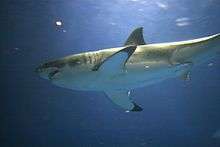
Prior to August 1981, no great white shark in captivity lived longer than 11 days. In August 1981, a great white survived for 16 days at SeaWorld San Diego before being released.[144] The idea of containing a live great white at SeaWorld Orlando was used in the 1983 film Jaws 3-D.
Monterey Bay Aquarium first attempted to display a great white in 1984, but the shark died after 11 days because it did not eat.[145] In July 2003, Monterey researchers captured a small female and kept it in a large netted pen near Malibu for five days. They had the rare success of getting the shark to feed in captivity before its release.[146] Not until September 2004 was the aquarium able to place a great white on long-term exhibit. A young female, which was caught off the coast of Ventura, was kept in the aquarium's 3.8 million l (1 million US gal) Outer Bay exhibit for 198 days before she was released in March 2005. She was tracked for 30 days after release.[147] On the evening of 31 August 2006, the aquarium introduced a juvenile male caught outside Santa Monica Bay.[148] His first meal as a captive was a large salmon steak on 8 September 2006, and as of that date, he was estimated to be 1.72 m (68 in) in length and to weigh approximately 47 kg (104 lb). He was released on 16 January 2007, after 137 days in captivity.
Monterey Bay Aquarium housed a third great white, a juvenile male, for 162 days between 27 August 2007, and 5 February 2008. On arrival, he was 1.4 m (4.6 ft) long and weighed 30.6 kg (67 lb). He grew to 1.8 m (5.9 ft) and 64 kg (141 lb) before release. A juvenile female came to the Outer Bay Exhibit on 27 August 2008. While she did swim well, the shark fed only one time during her stay and was tagged and released on 7 September 2008. Another juvenile female was captured near Malibu on 12 August 2009, introduced to the Outer Bay exhibit on 26 August 2009, and was successfully released into the wild on 4 November 2009.[149] The Monterey Bay Aquarium introduced a 1.4-m-long male into their redesigned "Open Sea" exhibit on 31 August 2011. He was exhibited for 55 days, and was released into the wild on the 25th October the same year. However, the shark was determined to have died shortly after release via an attached electronic tag. The cause of death is not known.[150][151][152]
The Monterey Bay Aquarium does not plan to exhibit any more great whites, as the main purpose of containing them was scientific. As data from captive great whites were no longer needed, the institute has instead shifted its focus to study wild sharks.[153]
One of the largest adult great whites ever exhibited was at Japan's Okinawa Churaumi Aquarium in 2016, where a 3.5 m (11 ft) male was exhibited for three days before dying.[154][155] Probably the most famous captive was a 2.4 m (7.9 ft) female named Sandy, which in August 1980 became the only great white to be housed at the California Academy of Sciences' Steinhart Aquarium in San Francisco, California. She was released because she would not eat and constantly bumped against the walls.[156]
Shark tourism
Cage diving is most common at sites where great whites are frequent including the coast of South Africa, the Neptune Islands in South Australia,[157] and Guadalupe Island in Baja California. The popularity of cage diving and swimming with sharks is at the focus of a booming tourist industry.[158][159] A common practice is to chum the water with pieces of fish to attract the sharks. These practices may make sharks more accustomed to people in their environment and to associate human activity with food; a potentially dangerous situation. By drawing bait on a wire towards the cage, tour operators lure the shark to the cage, possibly striking it, exacerbating this problem. Other operators draw the bait away from the cage, causing the shark to swim past the divers.
At present, hang baits are illegal off Isla Guadalupe and reputable dive operators do not use them. Operators in South Africa and Australia continue to use hang baits and pinniped decoys.[160] In South Australia, playing rock music recordings underwater, including the AC/DC album Back in Black has also been used experimentally to attract sharks.[161]
Companies object to being blamed for shark bite incidents, pointing out that lightning tends to strike humans more often than sharks bite humans.[162] Their position is that further research needs to be done before banning practices such as chumming, which may alter natural behaviour.[163] One compromise is to only use chum in areas where whites actively patrol anyway, well away from human leisure areas. Also, responsible dive operators do not feed sharks. Only sharks that are willing to scavenge follow the chum trail and if they find no food at the end then the shark soon swims off and does not associate chum with a meal. It has been suggested that government licensing strategies may help enforce these responsible tourism.[160]
The shark tourist industry has some financial leverage in conserving this animal. A single set of great white jaws can fetch up to £20,000. That is a fraction of the tourism value of a live shark; tourism is a more sustainable economic activity than shark fishing. For example, the dive industry in Gansbaai, South Africa consists of six boat operators with each boat guiding 30 people each day. With fees between £50 and £150 per person, a single live shark that visits each boat can create anywhere between £9,000 and £27,000 of revenue daily.
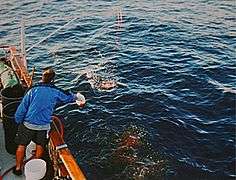
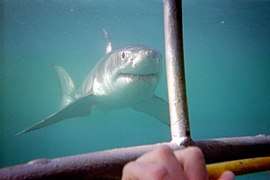 A great white shark approaches divers in a cage off Dyer Island, Western Cape, South Africa
A great white shark approaches divers in a cage off Dyer Island, Western Cape, South Africa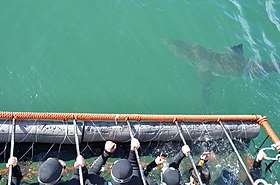 Tourists in a cage near Gansbaai
Tourists in a cage near Gansbaai
Conservation status
It is unclear how much of a concurrent increase in fishing for great white sharks has caused the decline of great white shark populations from the 1970s to the present. No accurate global population numbers are available, but the great white shark is now considered vulnerable.[2] Sharks taken during the long interval between birth and sexual maturity never reproduce, making population recovery and growth difficult.
The IUCN notes that very little is known about the actual status of the great white shark, but as it appears uncommon compared to other widely distributed species, it is considered vulnerable.[2] It is included in Appendix II of CITES,[15] meaning that international trade in the species requires a permit.[164] As of March 2010, it has also been included in Annex I of the CMS Migratory Sharks MoU, which strives for increased international understanding and coordination for the protection of certain migratory sharks.[165] A February 2010 study by Barbara Block of Stanford University estimated the world population of great white sharks to be lower than 3,500 individuals, making the species more vulnerable to extinction than the tiger, whose population is in the same range.[166] According to another study from 2014 by George H. Burgess, Florida Museum of Natural History, University of Florida, there are about 2,000 great white sharks near the California coast, which is 10 times higher than the previous estimate of 219 by Barbara Block.[167][168]
Fishermen target many sharks for their jaws, teeth, and fins, and as game fish in general. The great white shark, however, is rarely an object of commercial fishing, although its flesh is considered valuable. If casually captured (it happens for example in some tonnare in the Mediterranean), it is misleadingly sold as smooth-hound shark.[169]
In Australia
The great white shark was declared vulnerable by the Australian Government in 1999 because of significant population decline and is currently protected under the Environmental Protection and Biodiversity Conservation (EPBC) Act.[170] The causes of decline prior to protection included mortality from sport fishing harvests as well as being caught in beach protection netting.[171]
The national conservation status of the great white shark is reflected by all Australian states under their respective laws, granting the species full protection throughout Australia regardless of jurisdiction.[170] Many states had prohibited the killing or possession of great white sharks prior to national legislation coming into effect. The great white shark is further listed as threatened in Victoria under the Flora and Fauna Guarantee Act, and as rare or likely to become extinct under Schedule 5 of the Wildlife Conservation Act in Western Australia.[170]
In 2002, the Australian government created the White Shark Recovery Plan, implementing government-mandated conservation research and monitoring for conservation in addition to federal protection and stronger regulation of shark-related trade and tourism activities.[171] An updated recovery plan was published in 2013 to review progress, research findings, and to implement further conservation actions.[16] A study in 2012 revealed that Australia's white shark population was separated by Bass Strait into genetically distinct eastern and western populations, indicating a need for the development of regional conservation strategies.[172]
Presently, human-caused shark mortality is continuing, primarily from accidental and illegal catching in commercial and recreational fishing as well as from being caught in beach protection netting, and the populations of great white shark in Australia are yet to recover.[16]
In spite of official protections in Australia, great white sharks continue to be killed in state "shark control" programs within Australia. For example, the government of Queensland has a "shark control" program (shark culling) which kills great white sharks (as well as other marine life) using shark nets and drum lines with baited hooks.[173][130] In Queensland, great white sharks that are found alive on the baited hooks are shot.[134] The government of New South Wales also kills great white sharks in its "shark control" program.[130] Partly because of these programs, shark numbers in eastern Australia have decreased.[133]
The Australasian population of great white sharks is believed to be in excess of 8,000–10,000 individuals according to genetic research studies done by CSIRO, with an adult population estimated to be around 2,210 individuals in both Eastern and Western Australia. The annual survival rate for juveniles in these two separate populations was estimated in the same study to be close to 73 percent, while adult sharks had a 93 percent annual survival rate. Whether or not mortality rates in great white sharks have declined, or the population has increased as a result of the protection of this species in Australian waters is as yet unknown due to the slow growth rates of this species.[174]
In New Zealand
As of April 2007, great white sharks were fully protected within 370 km (230 mi) of New Zealand and additionally from fishing by New Zealand-flagged boats outside this range. The maximum penalty is a $250,000 fine and up to six months in prison.[175] In June 2018 the New Zealand Department of Conservation classified the great white shark under the New Zealand Threat Classification System as "Nationally Endangered". The species meets the criteria for this classification as there exists a moderate, stable population of between 1000 and 5000 mature individuals. This classification has the qualifiers "Data Poor" and "Threatened Overseas".[176]
In North America
In 2013, great white sharks were added to California's Endangered Species Act. From data collected, the population of great whites in the North Pacific was estimated to be fewer than 340 individuals. Research also reveals these sharks are genetically distinct from other members of their species elsewhere in Africa, Australia, and the east coast of North America, having been isolated from other populations.[177]
A 2014 study estimated the population of great white sharks along the California coastline to be approximately 2,400.[178][179]
In 2015 Massachusetts banned catching, cage diving, feeding, towing decoys, or baiting and chumming for its significant and highly predictable migratory great white population without an appropriate research permit. The goal of these restrictions is to both protect the sharks and public health.[180]
See also
Books
- The Devil's Teeth by Susan Casey
- Close to Shore by Michael Capuzzo about the Jersey Shore shark attacks of 1916
- Twelve Days of Terror by Richard Fernicola about the same events
References
- Gottfried, M. D.; Fordyce, R. E. (2001). "An associated specimen of Carcharodon angustidens (Chondrichthyes, Lamnidae) from the Late Oligocene of New Zealand, with comments on Carcharodon interrelationships". Journal of Vertebrate Paleontology. 21 (4): 730–739. doi:10.1671/0272-4634(2001)021[0730:AASOCA]2.0.CO;2. JSTOR 20062013.
- Rigby, C.L.; Barreto, R.; Carlson, J.; Fernando, D.; Fordham, S.; Francis, M.P.; Herman, K.; Jabado, R.W.; Liu, K.M.; Lowe, C.G.; Marshall, A.; Pacoureau, N.; Romanov, E.; Sherley, R.B.; Winker, H. (2019). "Carcharodon carcharias". IUCN Red List of Threatened Species. 2019: e.T3855A2878674. Retrieved 19 December 2019.
- "Great white sharks: 10 myths debunked". The Guardian. Retrieved 3 June 2016.
- Viegas, Jennifer. "Largest Great White Shark Don't Outweigh Whales, but They Hold Their Own". Discovery Channel. Retrieved 19 January 2010.
- "Just the Facts Please". GreatWhite.org. Retrieved 3 June 2016.
- Parrish, M. "How Big are Great White Sharks?". Smithsonian National Museum of Natural History Ocean Portal. Retrieved 3 June 2016.
- "Carcharodon carcharias". Animal Diversity Web. Retrieved 5 June 2016.
- "New study finds extreme longevity in white sharks". Science Daily. 9 January 2014.
- Ghose, Tia (19 February 2015). "Great White Sharks Are Late Bloomers". LiveScience.com.
- Klimley, A. Peter; Le Boeuf, Burney J.; Cantara, Kelly M.; Richert, John E.; Davis, Scott F.; Van Sommeran, Sean; Kelly, John T. (19 March 2001). "The hunting strategy of white sharks (Carcharodon carcharias) near a seal colony". Marine Biology. 138 (3): 617–636. doi:10.1007/s002270000489. ISSN 0025-3162.
- Thomas, Pete (5 April 2010). "Great white shark amazes scientists with 4,000-foot dive into abyss". GrindTV. Archived from the original on 17 August 2012.
- Currents of Contrast: Life in Southern Africa's Two Oceans. Struik. 2005. pp. 31–. ISBN 978-1-77007-086-8.
- Knickle, Craig. "Tiger Shark". Florida Museum of Natural History Ichthyology Department. Archived from the original on 7 July 2013. Retrieved 2 July 2009.
- "ISAF Statistics on Attacking Species of Shark". Florida Museum of Natural History University of Florida. Archived from the original on 24 April 2012. Retrieved 4 May 2008.
- "Carcharodon carcharias". UNEP-WCMC Species Database: CITES-Listed Species On the World Wide Web. Archived from the original on 16 June 2013. Retrieved 8 April 2010.
- Recovery Plan for the White Shark (Carcharodon carcharias) (Report). Government of Australia Department of Sustainability, Environment, Water, Population and Communities. 2013.
- Hile, Jennifer (23 January 2004). "Great White Shark Attacks: Defanging the Myths". Marine Biology. National Geographic. Archived from the original on 26 April 2009. Retrieved 2 May 2010.
- ISAF Statistics on Attacking Species of Shark
- Cronin, Melissa (10 January 2016). "Here's Why We've Never Been Able to Tame the Great White Shark".
- Linnaeus, Carl (1758). Systema Naturae per Regna Tria Naturae, Secundum Classes, Ordines, Genera, Species, cum Characteribus, Differentiis, Synonymis, Locis (in Latin). Vol. I (10th revised ed.). Holmiae: (Laurentii Salvii).
- "The Great White Shark". The Enviro Facts Project. Archived from the original on 13 June 2009. Retrieved 9 July 2007.
- Portell, R. W.; Hubbell, G.; Donovan, S. K.; Green, J. L.; Harper, D. A.; Pickerill, R. (2008). "Miocene sharks in the Kendeace and Grand Bay formations of Carriacou, The Grenadines, Lesser Antilles". Caribbean Journal of Science. 44 (3): 279–286. doi:10.18475/cjos.v44i3.a2.
- "New Ancient Shark Species Gives Insight Into Origin of Great White". sciencedaily.com. University of Florida. 14 November 2012.
- Kevin G. N.; Charles N. C.; Gregory A. W. (2006). "Tracing the Ancestry of the Great White Shark, Carcharodon carcharias, Using Morphometric Analyses of Fossil Teeth" (PDF). Journal of Vertebrate Paleontology. 26 (4): 806–814. doi:10.1671/0272-4634(2006)26[806:ttaotg]2.0.co;2. JSTOR 4524633. Archived from the original (PDF) on 16 December 2008. Retrieved 25 December 2007.
- "Areal Distribution of the White Shark". National Capital Freenet. Retrieved 16 October 2010.
- Kabasakal, H. (2014). "The status of the great white shark (Carcharodon carcharias) in Turkey's waters" (PDF). Marine Biodiversity Records. 7. doi:10.1017/S1755267214000980.
- "Seabird predation by white shark, Carcharodon carcharias, and Cape fur seal, Arctocephalus pusillus pusillus, at Dyer Island". South African Journal of Wildlife Research. Retrieved 22 May 2017.
- "South Africa – Australia – South Africa". White Shark Trust.
- Thomas, Pete (29 September 2006). "The Great White Way". Los Angeles Times. Retrieved 1 October 2006.
- Curtis, Tobey; McCandless, Camilla; Carlson, John; Skomal, Gregory; Kohler, Nancy; Natanson, Lisa; Burgess, George; Hoey, John; Pratt, Harold (June 2014). "Seasonal Distribution and Historic Trends in Abundance of White Sharks, Carcharodon carcharias, in the Western North Atlantic Ocean" (PDF). PLOS ONE. 9: 12. doi:10.1371/journal.pone.0099240.
- Fieldstadt, Elisha (2 August 2019). "More than 150 great white sharks sightings logged off Cape Cod, Massachusetts, since June". NBC News. Retrieved 5 August 2019.
- Wasser, Miriam (2 August 2019). "Seals On Cape Cod Are More Than Just Shark Bait". WBUR. Retrieved 5 August 2019.
- Annear, Steve (18 June 2019). "Tracking great white sharks off Cape Cod could help protect beachgoers". The Boston Globe. Retrieved 5 August 2019.
- Finucane, Martin (23 June 2018). "Great white sharks like to hang out in ocean eddies, new study says". The Boston Globe. Retrieved 23 June 2018.
- "Confirmed: 'Albino' great white shark washes up in Australia | Sharks | Earth Touch News". Earth Touch News Network.
- "Great White Sharks, Carcharodon carcharias". Marine Bio. Retrieved 20 August 2012.
- "Great White Sharks Have Blue Eyes". The Atlantic White Shark Conservancy. Retrieved 2 July 2018.
- Echenique, E. J. "A Shark to Remember: The Story of a Great White Caught in 1945". Archived from the original on 27 April 2012. Retrieved 22 January 2013. Home Page of Henry F. Mollet, Research Affiliate, Moss Landing Marine Laboratories.
- Tricas, T. C.; McCosker, J. E. (12 July 1984). "Predatory behaviour of the white shark (Carcharodon carcharias), with notes on its biology". Proceedings of the California Academy of Sciences. California Academy of Sciences. 43 (14): 221–238. Retrieved 22 January 2013.
- Wood, Gerald (1983). The Guinness Book of Animal Facts and Feats. ISBN 978-0-85112-235-9.
- Ellis, Richard and John E. McCosker. 1995. Great White Shark. Stanford University Press, ISBN 0-8047-2529-2
- "ADW: Carcharodon carcharias: Information". Animal Diversity Web. Retrieved 16 May 2016.
- Cappo, Michael (1988). "Size and age of the white pointer shark, Carcharodon carcharias (Linnaeus)". SAFISH. 13 (1): 11–13. Archived from the original on 6 January 2007.
- Taylor, Leighton R. (1 January 1993). Sharks of Hawaii: Their Biology and Cultural Significance. University of Hawaii Press. p. 65. ISBN 978-0-8248-1562-2.
- Wroe, S.; Huber, D. R.; Lowry, M.; McHenry, C.; Moreno, K.; Clausen, P.; Ferrara, T. L.; Cunningham, E.; Dean, M. N.; Summers, A. P. (2008). "Three-dimensional computer analysis of white shark jaw mechanics: how hard can a great white bite?" (PDF). Journal of Zoology. 276 (4): 336–342. doi:10.1111/j.1469-7998.2008.00494.x.
- "Great White Shark". National Geographic. Retrieved 24 July 2010.
- Mollet, H. F. (2008), White Shark Summary Carcharodon carcharias (Linnaeus, 1758)], Home Page of Henry F. Mollet, Research Affiliate, Moss Landing Marine Laboratories, archived from the original on 31 May 2012
- Klimley, Peter; Ainley, David (1996). Great White Sharks: The Biology of Carcharodon carcharias. Academic Press. pp. 91–108. ISBN 978-0-12-415031-7.
- Jury, Ken (1987). "Huge 'White Pointer' Encounter". SAFISH. 2 (3): 12–13. Archived from the original on 17 April 2012.
- "Learn More About Deep Blue, One of the Biggest Great White Sharks Ever Filmed". Discovery.
- Staff, H. N. N. "Biggest great white shark on record seen in Hawaii waters". Hawaii News.
- Ciaccia, Chris (16 January 2019). "Great white shark, called 'Deep Blue,' spotted near Hawaii". Fox News.
- "Deep Blue, perhaps the largest known great white shark, spotted off Hawaii". 16 January 2019.
- Armitage, Stefan (12 July 2019). "Fisherman encounters '30-foot' great white shark". Vt.co. Retrieved 28 November 2019.
- Ferreira, Craig (2011). Great White Sharks On Their Best Behavior.
- Froese, Rainer and Pauly, Daniel, eds. (2011). "Galeocerdo cuvier" in FishBase. July 2011 version.
- "Summary of Large Tiger Sharks Galeocerdo cuvier (Peron & LeSueur, 1822)". Archived from the original on 10 April 2012. Retrieved 3 May 2010.
- Eagle, Dane. "Greenland Shark". Florida Museum of Natural History. Retrieved 1 September 2012.
- Martin, R. Aidan. "Pacific Sleeper Shark". ReefQuest Centre for Shark Research. Biology of Sharks and Rays. Archived from the original on 20 April 2013. Retrieved 1 September 2012.
- "Largest Great White Shark Specimens by Paleonerd01 on DeviantArt". www.deviantart.com.
- Christiansen, Heather M.; Lin, Victor; Tanaka, Sho; Velikanov, Anatoly; Mollet, Henry F.; Wintner, Sabine P.; Fordham, Sonja V.; Fisk, Aaron T.; Hussey, Nigel E. (16 April 2014). "The Last Frontier: Catch Records of White Sharks (Carcharodon carcharias) in the Northwest Pacific Ocean". PLOS ONE. 9 (4): e94407. doi:10.1371/journal.pone.0094407. PMC 3989224. PMID 24740299 – via PLoS Journals.
- "White Shark Summary Carcharodon carcharias (Linnaeus, 1758)". www.elasmollet.org.
- Alessandro De Maddalena & Walter Heim (2015). Mediterranean Great White Sharks: A Comprehensive Study Including All Recorded Sightings. McFarland. ISBN 978-0786488155.
- https://www.researchgate.net/publication/277713896_On_the_great_white_shark_Carcharodon_carcharias_Linnaeus_1758_preserved_in_the_Museum_of_Zoology_in_Lausanne
- Nevres, M. Özgür (6 October 2018). "Largest great white sharks ever recorded". Our Planet.
- "(PDF) An analysis of photographic evidences of the largest great white sharks (Carcharodon carcharias), Linnaeus 1758, captures in the Mediterranean sea with considerations about the maximum size of the species". ResearchGate.
- "Squalus Carcharias: Le TRÈS Grand Requin Blanc !". 29 July 2013.
- Gerald L Wood (1982). Guinness Book of World Records Animal Facts and Feats. Sterling Pub Co., Inc. ISBN 978-0851122359.
- Molotsky, Irvin M (24 June 1978). "Harpooned Shark Pulls Fishing Boat 14 Hours Off L.I." New York Times.
- "Deep Blue". 19 March 2017.
- "One of biggest great white sharks seen feasting on sperm whale in rare video". Animals. 19 July 2019.
- "The Big One, a Great White story from Grand Manan". new-brunswick.net.
- Vladykov, Vadim D. (Vadim Dmitrij); McKenzie, Ross A. (17 May 1935). "The marine fishes of Nova Scotia". Proceedings of the Nova Scotian Institute of Science – via dalspace.library.dal.ca.
- "The physiology of the ampullae of Lorenzini in sharks". Biology Dept., Davidson College. Biology @ Davidson. Archived from the original on 24 November 2010. Retrieved 20 August 2012.
- Martin, R. Aidan. "Body Temperature of the Great white and Other Lamnoid Sharks". ReefQuest Centre for Shark research. Retrieved 16 October 2010.
- White Shark Biological Profile from the Florida Museum of Natural History
- Barber, Elizabeth (18 July 2013). "Great white shark packs its lunch in its liver before a big trip". The Christian Science Monitor. Archived from the original on 2 August 2013.
- Jordan, Rob (17 July 2013). "Great White Sharks' Fuel for Oceanic Voyages: Liver Oil". sciencedaily.com. Stanford University.
- Solly, Meilan (3 April 2019). "Great White Sharks Thrive Despite Heavy Metals Coursing Through Their Veins". Smithsonian Magazine. Archived from the original on 30 June 2019. Retrieved 30 June 2019.
- Medina, Samantha (27 July 2007). "Measuring the great white's bite". Cosmos Magazine. Archived from the original on 5 May 2012. Retrieved 1 September 2012.
- Martin, R. Aidan; Martin, Anne (October 2006). "Sociable Killers: New studies of the white shark (aka great white) show that its social life and hunting strategies are surprisingly complex". Natural History. Retrieved 24 November 2019.
- Martin, R. Aidan; Martin, Anne. "Sociable Killers". Natural History Magazine. Archived from the original on 15 May 2013. Retrieved 30 September 2006.
- Johnson, R. L.; Venter, A.; Bester, M.N.; Oosthuizen, W.H. (2006). "Seabird predation by white shark Carcharodon carcharias and Cape fur seal Arctocephalus pusillus pusillus at Dyer Island" (PDF). South African Journal of Wildlife Research. South Africa. 36 (1): 23–32. Archived from the original (PDF) on 3 April 2012.
- Teenage great white sharks are awkward biters. Science Daily (2 December 2010)
- White shark diets show surprising variability, vary with age and among individuals. Science Daily (29 September 2012)
- Estrada, J. A.; Rice, Aaron N.; Natanson, Lisa J.; Skomal, Gregory B. (2006). "Use of isotopic analysis of vertebrae in reconstructing ontogenetic feeding ecology in white sharks". Ecology. 87 (4): 829–834. doi:10.1890/0012-9658(2006)87[829:UOIAOV]2.0.CO;2. PMID 16676526.
- Fergusson, I. K.; Compagno, L. J.; Marks, M. A. (2000). "Predation by white sharks Carcharodon carcharias (Chondrichthyes: Lamnidae) upon chelonians, with new records from the Mediterranean Sea and a first record of the ocean sunfish Mola mola (Osteichthyes: Molidae) as stomach contents". Environmental Biology of Fishes. 58 (4): 447–453. doi:10.1023/a:1007639324360.
- Hussey, N. E., McCann, H. M., Cliff, G., Dudley, S. F., Wintner, S. P., & Fisk, A. T. (2012). Size-based analysis of diet and trophic position of the white shark (Carcharodon carcharias) in South African waters. Global Perspectives on the Biology and Life History of the White Shark. (Ed. ML Domeier.) pp. 27–49.
- "Catch as Catch Can". ReefQuest Centre for Shark Research. Retrieved 16 October 2010.
- Le Boeuf, B. J.; Crocker, D. E.; Costa, D. P.; Blackwell, S. B.; Webb, P. M.; Houser, D. S. (2000). "Foraging ecology of northern elephant seals". Ecological Monographs. 70 (3): 353–382. doi:10.2307/2657207. JSTOR 2657207.
- Haley, M. P.; Deutsch, C. J.; Le Boeuf, B. J. (1994). "Size, dominance and copulatory success in male northern elephant seals, Mirounga angustirostris". Animal Behaviour. 48 (6): 1249–1260. doi:10.1006/anbe.1994.1361.
- Weng, K. C.; Boustany, A. M.; Pyle, P.; Anderson, S. D.; Brown, A.; Block, B. A. (2007). "Migration and habitat of white sharks (Carcharodon carcharias) in the eastern Pacific Ocean". Marine Biology. 152 (4): 877–894. doi:10.1007/s00227-007-0739-4.
- Martin, Rick. "Predatory Behavior of Pacific Coast White Sharks". Shark Research Committee. Archived from the original on 30 July 2012.
- Chewning, Dana; Hall, Matt. "Carcharodon carcharias (Great white shark)". Animal Diversity Web. Retrieved 15 August 2019.
- Heithaus, Michael (2001). "Predator–prey and competitive interactions between sharks (order Selachii) and dolphins (suborder Odontoceti): a review" (PDF). Journal of Zoology. 253: 53–68. CiteSeerX 10.1.1.404.130. doi:10.1017/S0952836901000061. Archived from the original (PDF) on 15 January 2016. Retrieved 26 February 2010.
- Long, Douglas (1991). "Apparent Predation by a White Shark Carcharodon carcharias on a Pygmy Sperm Whale Kogia breviceps" (PDF). Fishery Bulletin. 89: 538–540.
- Kays, R. W., & Wilson, D. E. (2009). Mammals of North America. Princeton University Press.
- Baird, R. W.; Webster, D. L.; Schorr, G. S.; McSweeney, D. J.; Barlow, J. (2008). "Diet variation in beaked whale diving behavior" (PDF). Marine Mammal Science. 24 (3): 630–642. doi:10.1111/j.1748-7692.2008.00211.x. hdl:10945/697.
- "How Fast Can a Shark Swim?". ReefQuest Centre for Shark Research.
- "White Shark Predatory Behavior at Seal Island". ReefQuest Centre for Shark Research.
- Krkosek, Martin; Fallows, Chris; Gallagher, Austin J.; Hammerschlag, Neil (2013). "White Sharks (Carcharodon carcharias) Scavenging on Whales and Its Potential Role in Further Shaping the Ecology of an Apex Predator". PLoS ONE. 8 (4): e60797. doi:10.1371/journal.pone.0060797. PMC 3621969. PMID 23585850.
- Dudley, Sheldon F. J.; Anderson-Reade, Michael D.; Thompson, Greg S.; McMullen, Paul B. (2000). "Concurrent scavenging off a whale carcass by great white sharks, Carcharodon carcharias, and tiger sharks, Galeocerdo cuvier" (PDF). Marine Biology. Fishery Bulletin. Archived from the original (PDF) on 27 May 2010. Retrieved 4 May 2010.
- Dines, Sasha; Gennari, Enrico (29 January 2020). "First observations of white sharks (Carcharodon carcharias) attacking a live humpback whale (Megaptera novaeangliae)". Marine and Freshwater Research. doi:10.1071/MF19291 – via www.publish.csiro.au.
- Márquez, Melissa Cristina. "First Observations Of White Sharks Attacking A Live Humpback Whale". Forbes.
- "Drone footage shows a great white shark drowning a 33ft humpback whale". The Independent. 15 July 2020.
- Fish, Tom (15 July 2020). "Shark attack: Watch 'strategic' Great White hunt down and kill 10 Metre humpback whale". Express.co.uk.
- Owens, Brian (12 February 2016). "White shark's diet may include biggest fish of all: whale shark". New Scientist.
- Moore, G. I.; Newbrey, M. G. (2015). "Whale shark on a white shark's menu". Marine Biodiversity. 46 (4): 745. doi:10.1007/s12526-015-0430-9.
- "Natural History of the White Shark". PRBO Conservation Science. 2 May 2010. Archived from the original on 3 July 2013.
- "Legendary Great White Shark Was Just A Teenager When Killed, New Research Reveals". The Inquisitr News.
- "Carcharodon carcharias, Great White Sharks". marinebio.org.
- "Brief Overview of the Great White Shark (Carcharodon carcharias)". Elasmo Research. Retrieved 20 August 2012.
- Animals, Kimberly Hickok 2019-03-22T19:03:40Z. "Enormous Great White Shark Pregnant with Record 14 Pups Was Caught and Sold in Taiwan". livescience.com.
- Martin, R. Aidan. "White Shark Breaching". ReefQuest Centre for Shark Research. Retrieved 18 April 2012.
- Martin, R. A.; Hammerschlag, N.; Collier, R. S.; Fallows, C. (2005). "Predatory behaviour of white sharks (Carcharodon carcharias) at Seal Island, South Africa". Journal of the Marine Biological Association of the UK. 85 (5): 1121. CiteSeerX 10.1.1.523.6178. doi:10.1017/S002531540501218X.
- Rice, Xan (19 July 2011). "Great white shark jumps from sea into research boat". The Guardian. London: Guardian Media Group. Retrieved 20 July 2011.
Marine researchers in South Africa had a narrow escape after a 3 m (10 ft) long great white shark breached the surface of the sea and leapt into their boat, becoming trapped on deck for more than an hour. [...] Enrico Gennari, an expert on great white sharks, [...] said it was almost certainly an accident rather than an attack on the boat.
- Pyle, Peter; Schramm, Mary Jane; Keiper, Carol; Anderson, Scot D. (26 August 2006). "Predation on a white shark (Carcharodon carcharias) by a killer whale (Orcinus orca) and a possible case of competitive displacement" (PDF). Marine Mammal Science. 15 (2): 563–568. doi:10.1111/j.1748-7692.1999.tb00822.x. Archived from the original (PDF) on 22 March 2012. Retrieved 8 May 2010.
- "Nature Shock Series Premiere: The Whale That Ate the Great White". Tvthrong.co.uk. 4 October 1997. Archived from the original on 6 April 2012. Retrieved 16 October 2010.
- "Killer Whale Documentary Part 4". youtube.com.
- Turner, Pamela S. (October–November 2004). "Showdown at Sea: What happens when great white sharks go fin-to-fin with killer whales?". National Wildlife. National Wildlife Federation. 42 (6). Archived from the original on 16 January 2011. Retrieved 21 November 2009.
- "Great white shark 'slammed' and killed by a pod of killer whales in South Australia". Australian Broadcasting Corporation. 3 February 2015. Retrieved 10 July 2015.
- Haden, Alexis (6 June 2017). "Killer whales have been killing great white sharks in Cape waters". The South African. Retrieved 27 June 2017.
- Jorgensen, S. J.; et al. (2019). "Killer whales redistribute white shark foraging pressure on seals". Scientific Reports. 9 (1): 6153. Bibcode:2019NatSR...9.6153J. doi:10.1038/s41598-019-39356-2. PMC 6467992. PMID 30992478.
- Starr, Michell (11 November 2019). "Incredible Footage Reveals Orcas Chasing Off The Ocean's Most Terrifying Predator". Science Alert. Retrieved 24 November 2019.
- Benchley, Peter (April 2000). "Great white sharks". National Geographic: 12. ISSN 0027-9358.
considering the knowledge accumulated about sharks in the last 25 years, I couldn't possibly write Jaws today ... not in good conscience anyway ... back then, it was OK to demonize an animal.
- "Great White Shark Attacks: Defanging the Myths". nationalgeographic.com.
- Martin, R. Aidan (2003). "White Shark Attacks: Mistaken Identity". Biology of Sharks and Rays. ReefQuest Centre for Shark Research. Retrieved 30 August 2016.
- "ISAF Statistics for Worldwide Unprovoked White Shark Attacks Since 1990". 10 February 2011. Retrieved 19 August 2011.
- Tricas, T.C.; McCosker, John (1984). "Predatory behavior of the white shark, Carcharodon carcharias, and notes on its biology". Proceedings of the California Academy of Sciences. Series 4. 43 (14): 221–238.
- https://web.archive.org/web/20181002102324/https://www.marineconservation.org.au/pages/shark-culling.html marineconservation.org.au. Shark culling (archived). Archived from the original on 2 October 2018. Retrieved 30 August 2019.
- Phillips, Jack (4 September 2018), Video: Endangered Hammerhead Sharks Dead on Drum Line in Great Barrier Reef, Ntd.tv, archived from the original on 19 September 2018, retrieved 30 August 2019
- Thom Mitchell (20 November 2015), Action for Dolphins. Queensland's Shark Control Program Has Snagged 84,000 Animals, retrieved 30 August 2019
- Roff, George; Brown, Christopher J.; Priest, Mark A.; Mumby, Peter J. (2018). "Decline of coastal apex shark populations over the past half century". Communications Biology. 1 (1): 1–11. doi:10.1038/s42003-018-0233-1.
- http://www.onegreenplanet.org/news/brutal-lengths-australia-going-order-keep-sharks-away-tourists/ One Green Planet. Heartbreaking Photos Show the Brutal Lengths Australia Is Going to In Order to 'Keep Sharks Away From Tourists'. Kelly Wang. Retrieved 29 August 2019.
- Mackenzie, Bruce (4 August 2018), Sydney Shark Nets Set to Stay Despite Drumline Success, Swellnet.com., retrieved 30 August 2019
- Shark Nets, Sharkangels.org, retrieved 30 August 2019
- "New measures to combat WA shark risks". Department of Fisheries, Western Australia. 10 December 2013. Retrieved 2 February 2014.
- Arup, Tom (21 January 2014), "Greg Hunt grants WA exemption for shark cull plan", The Sydney Morning Herald, Fairfax Media, archived from the original on 22 January 2014
- "Can governments protect people from killer sharks?". Australian Broadcasting Corporation. 22 December 2013. Retrieved 2 February 2014.
- Australia shark policy to stay, despite threats TVNZ, 20 January 2014.
- "More than 100 shark scientists, including me, oppose the cull in Western Australia". 23 December 2013. Retrieved 31 August 2016.
- "Unprovoked White Shark Attacks on Kayakers". Shark Research Committee. Retrieved 14 September 2008.
- Tricas, Timothy C.; McCosker, John E. (1984). "Predatory Behaviour of the White Shark (Carcharodon carcharias), with Notes on its Biology" (PDF). Proceedings of the California Academy of Sciences. 43 (14): 221–238.
- "Great white shark sets record at California aquarium". USA Today. 2 October 2004. Retrieved 27 September 2006.
- Hopkins, Christopher Dean (8 January 2016). "Great White Shark Dies After Just 3 Days In Captivity At Japan Aquarium". NPR. Archived from the original on 3 April 2017. Retrieved 21 December 2017.
- Gathright, Alan (16 September 2004). "Great white shark puts jaws on display in aquarium tank". San Francisco Chronicle. Retrieved 27 September 2006.
- "White Shark Research Project". Monterey Bay Aquarium. Archived from the original on 19 January 2013. Retrieved 27 September 2006.
- Squatriglia, Chuck (1 September 2003). "Great white shark introduced at Monterey Bay Aquarium". San Francisco Chronicle. Retrieved 27 September 2006.
- "Learn All About Our New White Shark". Monterey Bay Aquarium. Archived from the original on 20 November 2009. Retrieved 28 August 2009.
- "New great white shark goes on display at Monterey Bay Aquarium". 1 September 2011.
- "Great White Shark Dies Shortly After Release From Monterey Aquarium". 3 November 2011.
- "Great white shark dies after release from Monterey Bay Aquarium". Los Angeles Times. 3 November 2011.
- https://www.montereybayaquarium.org/animals/animals-a-to-z/white-shark
- Hongo, Jun. "Great White Shark Dies at Aquarium in Japan". WSJ Blogs – Japan Real Time. Retrieved 9 January 2016.
- "Great white shark dies after three days in Japanese aquarium". Telegraph.co.uk. Retrieved 9 January 2016.
- "Electroreception". Elasmo-research. Retrieved 27 September 2006.
- "Shark cage diving". Department of Environment, Water and Natural Resources. Archived from the original on 9 April 2013. Retrieved 11 March 2013.
- Squires, Nick (18 January 1999). "Swimming With Sharks". BBC. Archived from the original on 17 August 2003. Retrieved 21 January 2010.
- Simon, Bob (11 December 2005). "Swimming With Sharks". 60 Minutes. Retrieved 22 January 2010.
- "Blue Water Hunting Successfully". Blue Water Hunter. Archived from the original on 18 August 2012. Retrieved 20 August 2012.
- "A Great white shark's favorite tune? 'Back in Black'" Archived 16 April 2016 at the Wayback Machine Surfersvillage Global Surf News (3 June 2011). Retrieved 30 January 2014.
- "Shark Attacks Compared to Lightning". Florida Museum of Natural History. 18 July 2003. Retrieved 7 November 2006.
- Hamilton, Richard (15 April 2004). "SA shark attacks blamed on tourism". BBC. Archived from the original on 23 March 2012. Retrieved 24 October 2006.
- "Regulation of Trade in Specimens of Species Included in Appendix II". CITES (1973). Archived from the original on 17 July 2011. Retrieved 8 April 2012.
- "Memorandum of Understanding on the Conservation of Migratory Sharks" (PDF). Convention on Migratory Species. 12 February 2010. Archived from the original (PDF) on 20 April 2013. Retrieved 31 August 2012.
- Sample, Ian (19 February 2010). "Great white shark is more endangered than tiger, claims scientist". The Guardian. Retrieved 14 August 2013.
- Jenkins, P. Nash (24 June 2014). "Beachgoers Beware: The Great White Shark Population Is Growing Again". Time. Retrieved 29 October 2014.
- Gannon, Megan. "Great White Sharks Are Making a Comeback off US Coasts". livescience.com. Retrieved 29 October 2014.
- De Maddalena, Alessandro; Heim, Walter (2012). Mediterranean Great White Sharks: A Comprehensive Study Including All Recorded Sightings. McFarland. ISBN 978-0-7864-5889-9.
- Government of Australia. "Species Profile and Threats Database – Carcharodon carcharias—Great White Shark". Retrieved 21 August 2013.
- Environment Australia (2002). White Shark (Carcharodon carcharias) Recovery Plan (Report).
- Blower, Dean C.; Pandolfi, John M.; Bruce, Barry D.; Gomez-Cabrera, Maria del C.; Ovenden, Jennifer R. (2012). "Population genetics of Australian white sharks reveals fine-scale spatial structure, transoceanic dispersal events and low effective population sizes". Marine Ecology Progress Series. 455: 229–244. doi:10.3354/meps09659.
- https://www.seashepherd.org.au/apex-harmony/overview/about-the-campaign.html "About the Campaign: Sea Shepherd Working Together With The Community To Establish Sustainable Solutions To Shark Bite Incidents". Retrieved 29 August 2019.
- Hillary, Rich; Bradford, Russ; Patterson, Toby. "World-first genetic analysis reveals Aussie white shark numbers". The Conversation.
- "Great white sharks to be protected". The New Zealand Herald. 30 November 2006. Retrieved 30 November 2006.
- Duffy, Clinton A. J.; Francis, Malcolm; Dunn, M. R.; Finucci, Brit; Ford, Richard; Hitchmough, Rod; Rolfe, Jeremy (2018). Conservation status of New Zealand chondrichthyans (chimaeras, sharks and rays), 2016 (PDF). Wellington, New Zealand: Department of Conservation. p. 9. ISBN 978-1-988514-62-8. OCLC 1042901090.
- Quan, Kristene (4 March 2013). "Great White Sharks Are Now Protected under California Law". Time.
- Williams, Lauren (3 July 2014). "Shark numbers not tanking". Huntington Beach Wave. The Orange County Register. p. 12.
- Burgess, George H.; Bruce, Barry D.; Cailliet, Gregor M.; Goldman, Kenneth J.; Grubbs, R. Dean; Lowe, Christopher J.; MacNeil, M. Aaron; Mollet, Henry F.; Weng, Kevin C.; O'Sullivan, John B. (16 June 2014). "A Re-Evaluation of the Size of the White Shark (Carcharodon carcharias) Population off California, USA". PLoS ONE. 9 (6): e98078. doi:10.1371/journal.pone.0098078. PMC 4059630. PMID 24932483.
- New Regulations Affecting Activity around White Sharks. Commonwealth of Massachusetts, Division of Marine Fisheries (4 June 2015)
External links
- Great white feasting on a whale's carcass
- Great white survives attack by orcas (killer whales) near Neptune Islands, Australia
- Great white and orca fight off the coast of California
- Great whites with a pod of orcas off the coast of South Africa
- Ocean Ramsey Encounters GIANT 20 ft (6.1 m) Great White Shark, near Oahu, Hawaii
- Longest Shark Ever Recorded!

